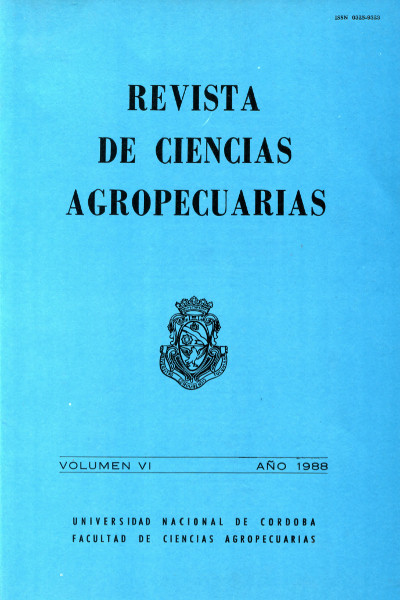The Rhizobium-Leguminosa Association in alfalfa fields in the Province of Córdoba. Second Stage: Field inoculation
Main Article Content
Abstract
As a second step in Rhizobium meliloti strain selection, field trials were conducted in the central region of Córdoba, Argentina. The main objective was to assess its N-fixation ability under local average climate-soil-plant conditions, compared with other strains from different sources, and to evaluate its response to massive or multiple inoculation methods in order to address competition problems. Medicago sativa L. cv. Polihíbrido Manfredi seeds were planted in a completely randomized block design with 5 repetitions over 2 seasons. Dry matter and N-content (as protein percentage) were determined at 3 cuttings when the crop reached 10% flowering. The results showed an increase in yield and protein content with inoculation, even with a high indigenous population. Under these ecological conditions, both selected indigenous strains and those recommended by INTA showed similar behavior in terms of N-fixation ability, and no differences were detected in response to inoculation methods (simple or multiple).
Article Details
Issue
Section

This work is licensed under a Creative Commons Attribution-ShareAlike 4.0 International License.
How to Cite
References
Adil' Bekova, K. H. K., & Yakushenko, A. D. (1977). Effect of some trace elements on nitrogen fixation and alfalfa yield. Izu AKAD. Nauk. S.S.R. Sec. Biol., 15, 52-57.
Alexander, M. (1980). Microbiología del Suelo. Libros y Editoriales S. A.
Barber, L. (1978). Survival and plant nodulation at low pH by resistant Rhizobium meliloti strains. Abstracts of the Annual Meeting of the American Society for Microbiology, 167, 78.
Brockwell, J., & Whalley, R. D. B. (1970). Studies on seed pelleting as an aid to legume seed inoculation. 2. Survival of Rhizobium meliloti applied to medic seed sown into dry soil. Australian Journal of Experimental Agriculture and Animal Husbandry, 10, 455-459.
Cardoso, E. (1979). Efeitos de fatores biológicos e não biológicos sobre a nodulação e fixação do N. En Curso Rápido sobre tecnologia de Rhizobium. MIRCEN, Porto Alegre, Brasil.
Gibson, A. H. (1971). Factors in the physical and biological environment affecting nodulation and nitrogen fixation by legumes. Plant and Soil, Special Volume, 139.
Heichel, G. H., & Vance, C. (1979). Nitrate-N and Rhizobium strain roles in alfalfa seedling nodulation and growth. Crop Science, 19, 512-518.
Kamberger, W. (1977). Regulation of symbiotic nitrogen fixation in root nodules of alfalfa (Medicago sativa) infected with Rhizobium meliloti. Archives of Microbiology, 115, 103-108.
Munns, D. M., Fogle, V. W., & Hallock, B. G. (1977). Alfalfa root nodule distribution and inhibition of nitrogen fixation by heat. Agronomy Journal, 69, 377.
Ponte, R. P., & Couto de Faedo, M. (1980). La asociación Rhizobium-Leguminosa en alfalfares de la Pcia. de Cba. Primera Etapa: Selección de cepas autóctonas de Rhizobium meliloti: Determinación de efectividad, infectividad y especificidad cultivar/cepa. Revista de Ciencias Agropecuarias, 1, 69-79.
Rice, W. A., Penney, D. C., & Nyborg, M. (1977). Effects of soil acidity on rhizobia numbers, nodulation, and nitrogen fixation by alfalfa and red clover. Canadian Journal of Soil Science, 57, 197-204.
Ruschell, A. (1979). Ecologia do Rhizobium. En Curso rápido sobre tecnologia de Rhizobium. MIRCEN, Porto Alegre, Brasil.
Sagardoy, M. A. (1981). Number and distribution of Rhizobium meliloti and other microbial populations in soils. Anales de Edafología y Agrobiología, XL(5-6), 889-894. Universidad Nacional del Sur, Bahía Blanca, Argentina.
Sakal, R. R., & Rohlf, F. (1979). Biometría. Ed. Blume.
Sprent, J. J. (1971). Effects of water stress on nitrogen fixation in root nodules. Plant and Soil, Special Volume, 225.
Steel, R. G. D., & Torrie, J. H. (1960). Principles and Procedures of Statistics. McGraw Hill.
Subba Rao, N., Lakshni-Kumari, M., & Singehc, M. (1974). Salinity and alkalinity in relation to legume-Rhizobium symbiosis. Proceedings of the Indian National Science Academy, 40(5), 544-547. Division of Microbiology, Indian Agricultural Research Institute.
Vidor, C. (1979). Estudos ecológicos do Rhizobium no solo. En Curso rápido sobre tecnologia de Rhizobium. MIRCEN, Porto Alegre, Brasil.
Wagner, G. H., Kassim, G. M., & Martyniuk, S. (1978). Nodulation of annual Medicago by strains of Rhizobium meliloti in a commercial inoculant as influenced by soil phosphorus and pH. Plant and Soil, 50, 81-89.





